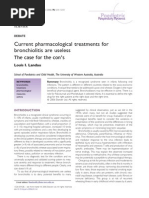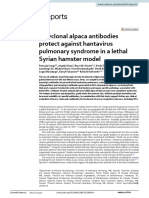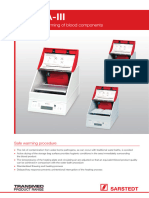2012 Theisen LL Et Al.
2012 Theisen LL Et Al.
Uploaded by
vishdubey777Copyright:
Available Formats
2012 Theisen LL Et Al.
2012 Theisen LL Et Al.
Uploaded by
vishdubey777Original Title
Copyright
Available Formats
Share this document
Did you find this document useful?
Is this content inappropriate?
Copyright:
Available Formats
2012 Theisen LL Et Al.
2012 Theisen LL Et Al.
Uploaded by
vishdubey777Copyright:
Available Formats
15th ICID Abstracts / International Journal of Infectious Diseases 16S (2012) e2–e157 e95
Type: Poster Presentation Type: Poster Presentation
Final Abstract Number: 40.058 Final Abstract Number: 40.059
Session: Virology and Viral Infections (Non-HIV) Session: Virology and Viral Infections (Non-HIV)
Date: Thursday, June 14, 2012 Date: Thursday, June 14, 2012
Time: 12:45-14:15 Time: 12:45-14:15
Room: Poster & Exhibition Area Room: Poster & Exhibition Area
EPs® 7630 (Umckaloabo®), an extract from Pelargonium Acute encephalitis in children caused by influenza virus-AH1N1
sidoides roots, exerts anti-influenza virus activity in vitro and
G. Jugulete 1 , M. Luminos 2,∗ , M.M. Merisescu 3 , A. Draganescu 4 , A.
in vivo
Visan 5 , M. Vasile 1 , A. Bilasco 1
L.L. Theisen, S. Gohrbandt, C.P. Muller, N. Luetteke ∗ 1 Institute of Infectious Diseases “Prof. dr. Matei Bals”, Bucharest,
Centre de Recherche Public de la Santé / National Public Health Labo- Romania
ratory, Luxembourg, Luxembourg 2 Infectious diseases national institute “Prof. dr. Matei Bals”, Bucharest,
Romania
Background: A prodelphinidin-rich extract from Pelargonium 3 National Institute for Infectious Diseases “Prof. Dr. Matei Bals”,
sidoides DC, EPs® 7630 (Umckaloabo®), which is licensed to treat
Bucharest, Romania
respiratory tract infections such as acute bronchitis, was investi- 4 Institute of Infectiouse Diseases “Prof. dr. Matei Bals”, Bucharest,
gated for its antiviral effects.
Romania
Methods: The efficacy of EPs® 7630 on influenza A virus prop- 5 Institute of Infectious Diseases, Bucharest, Romania
agation was investigated in vitro against different strains, after
different infection and treatment timepoints and by neuraminidase Background: Worldwide, seasonal flu epidemics remains a
and hemagglutination inhibition assays. Isolated monomers, major public health problem. Most recent pandemic influenza, with
dimers and oligo-/polymeric fractions were compared for antivi- AH1N1 virus, also included Romania. Acute encephalitis is one of
ral activity. In vivo, EPs® 7630 was investigated after inhalative the most severe complications of influenza in children.
application. Methods: In this article, we present two clinical cases of acute
Results: EPs® 7630 showed dose-dependent anti-influenza encephalitis in children caused by AH1N1 influenza virus, that
activity at non toxic concentrations against pandemic H1N1, were hospitalized in Pediatric Intensive care unit of the National
Oseltamivir sensitive and resistant seasonal H1N1, seasonal H3N2 Institute of Infectious Diseases “Prof. Dr. Matei Bals” in Bucharest.
and the laboratory H1N1 strain A/Puerto Rico/8/34, while it had Positive diagnosis was established on clinical, epidemiological and
no antiviral activity against adenovirus or measles virus. The laboratory data. Diagnosis confirmation was made by RT-PCR from
extract inhibited an early step of influenza infection and impaired nasal-pharyngeal secretions of patients. MRI examination was per-
viral hemagglutination as well as neuraminidase activity. How- formed in both cases and it showed disseminated encephalitis
ever, EPs® 7630 did not exhibit a direct virucidal effect, as virus outbreaks located especially in the brainsteam, in the first case and
preincubation (unlike cell preincubation) with the extract did not for the second patient subarachnoid hemorrhage with the absence
influence infectivity. Analysis of EPs® 7630 constituents revealed of cerebral circulation. The EEG examination confirmed the diag-
that prodelphinidins represent the active principle. Chain length nosis for both patients. They both were treated with Oseltamivir
influenced antiviral activity, as monomers and dimers were less and cortisone in high doses.
effective than oligo- and polymers. Importantly, gallocatechin and Results: The outcome for both patients was grave, the first one
its stereoisomer epigallocatechin exert antiviral activity also in presented severe mental and physical retardation and the second
their monomeric form. In addition, EPs® 7630 administered by one required oral-tracheal intubation and mechanical ventilation
inhalation significantly improved survival, body weight and body for 90 days but still had fatal evolution.
temperature of influenza-infected mice, without obvious toxicity, Conclusion: The flu caused by AH1N1 virus can have severe evo-
demonstrating the benefit of EPs® 7630 in treatment of influenza. lution into encephalitis or other neurological complications or even
Conclusion: In this study, we investigated the anti-influenza death. Establishing early diagnosis and proper treatment may be
mechanism of EPs® 7630 and demonstrate its efficacy in vitro and the key for a good outcome and prognosis improvement.
in vivo. The extract shows a robust effect against multiple different
IAV strains in vitro and protection of mice against a lethal virus http://dx.doi.org/10.1016/j.ijid.2012.05.221
challenge at non-toxic concentrations, underlining the benefit of
EPs® 7630 as a treatment for influenza virus infection.
http://dx.doi.org/10.1016/j.ijid.2012.05.220
You might also like
- Kronmed: Congresul Național Pentru Studenți Și Tineri MediciDocument87 pagesKronmed: Congresul Național Pentru Studenți Și Tineri MediciIubiNo ratings yet
- Cough: Neurophysiology, Methods of Research, Pharmacological Therapy and PhonoaudiologyDocument10 pagesCough: Neurophysiology, Methods of Research, Pharmacological Therapy and Phonoaudiologynadya shifaNo ratings yet
- Laringotraqueitis DX y Tto - En.esDocument9 pagesLaringotraqueitis DX y Tto - En.esCarolina Mora RuedaNo ratings yet
- Dengue Infection Presenting With Central Nervous System ManifestationDocument5 pagesDengue Infection Presenting With Central Nervous System ManifestationAmirah FaridahNo ratings yet
- Crup Revision PDFDocument9 pagesCrup Revision PDFEmily Gabriela Caicedo RuedaNo ratings yet
- Sarcoidose JamaDocument13 pagesSarcoidose JamafilipemateusoliveiraNo ratings yet
- Part 2 KROK-1Document46 pagesPart 2 KROK-1Jack frimpongNo ratings yet
- Whooping Cough 2016Document43 pagesWhooping Cough 2016TataroiElenaNo ratings yet
- Tonsillectomy and Adenoidectomy and Myringotomy With Tube InsertionDocument12 pagesTonsillectomy and Adenoidectomy and Myringotomy With Tube Insertionlolamusic90No ratings yet
- Treatment of Acute Otitis Externa With Ciprofloxacin Otic 0.2% Antibiotic Ear SolutionDocument12 pagesTreatment of Acute Otitis Externa With Ciprofloxacin Otic 0.2% Antibiotic Ear SolutionNana HeriyanaNo ratings yet
- Diagnosis and Treatment of Chronic CoughFrom EverandDiagnosis and Treatment of Chronic CoughSang Heon ChoNo ratings yet
- Referensi 1Document13 pagesReferensi 1yoghaNo ratings yet
- Microbial Diseases of The Respiratory System: Pertussis (Whooping Cough) PathogenesisDocument15 pagesMicrobial Diseases of The Respiratory System: Pertussis (Whooping Cough) PathogenesisCharlene SibugNo ratings yet
- ARDSDocument9 pagesARDSrayalarasatitiNo ratings yet
- Identification of Alloiococcus Otitidis, StreptococcusDocument15 pagesIdentification of Alloiococcus Otitidis, StreptococcusGeaby Magistha IrawanNo ratings yet
- Nasopharyngeal Carriage in Children After The Introduction of Generalized Infant Pneumococcal Conjugate Vaccine Immunization in GermanyDocument13 pagesNasopharyngeal Carriage in Children After The Introduction of Generalized Infant Pneumococcal Conjugate Vaccine Immunization in GermanyWelisson BarbosaNo ratings yet
- E20163927 FullDocument6 pagesE20163927 Fullmien cahyaniNo ratings yet
- Siupsinskiene Hpylori Archives 2013Document9 pagesSiupsinskiene Hpylori Archives 2013Nurul HidayatiNo ratings yet
- Paediatric Acute Encephalitis: Infection and InflammationDocument10 pagesPaediatric Acute Encephalitis: Infection and InflammationRajeshKoriyaNo ratings yet
- 1 s2.0 S1896112615000498 MainDocument6 pages1 s2.0 S1896112615000498 MainNELSON VIDIGALNo ratings yet
- Oropharyngeal and Nasopharyngeal Sampling For TheDocument7 pagesOropharyngeal and Nasopharyngeal Sampling For TheAna-Mihaela BalanuțaNo ratings yet
- Atypical MeaslesDocument2 pagesAtypical MeaslesBagusPranataNo ratings yet
- Role of Viral Infection in Sudden Hearing Loss: Xin Chen, Yao-Yao Fu and Tian-Yu ZhangDocument8 pagesRole of Viral Infection in Sudden Hearing Loss: Xin Chen, Yao-Yao Fu and Tian-Yu Zhanggeraldi radityaNo ratings yet
- Expiratory Flow Accelerator Efa For Dysphagic Noncoooperative Patients A Pilot Study For Preventing Aspiration PneumoniaDocument8 pagesExpiratory Flow Accelerator Efa For Dysphagic Noncoooperative Patients A Pilot Study For Preventing Aspiration PneumoniaScivision PublishersNo ratings yet
- Viral Etiology and Symptoms of Acute Upper Respiratory Tract Infections in ChildrenDocument7 pagesViral Etiology and Symptoms of Acute Upper Respiratory Tract Infections in ChildrenSeptian Sapta HadiNo ratings yet
- Piis0140673610614596 PDFDocument12 pagesPiis0140673610614596 PDFMagdalenoNo ratings yet
- Invasive Aspergillosis in A Patient With End StageDocument8 pagesInvasive Aspergillosis in A Patient With End StageDhurgham QuasimNo ratings yet
- Oxygen Therapy of Very Low Birth Weight Neonates With PneumoniaDocument5 pagesOxygen Therapy of Very Low Birth Weight Neonates With PneumoniaYohana TrissyaNo ratings yet
- Pneumonias in Children Practical Policies For StudentsDocument45 pagesPneumonias in Children Practical Policies For StudentsIbtissame BadadNo ratings yet
- Pelargonium (2018) Careddu DDocument8 pagesPelargonium (2018) Careddu DSalvador Gonzalez MercadoNo ratings yet
- Thesis Protocol For M.S. Degree (Ophthalmology)Document31 pagesThesis Protocol For M.S. Degree (Ophthalmology)zebaNo ratings yet
- Chary Et Al 2020 Prevalence and Recovery From Olfactory and Gustatory Dysfunctions in Covid 19 Infection A ProspectiveDocument8 pagesChary Et Al 2020 Prevalence and Recovery From Olfactory and Gustatory Dysfunctions in Covid 19 Infection A Prospectiveika nurul shofiyahNo ratings yet
- Aspiration Pneumonia in Children With Neurological Disorders A New Indication For Lung Ultrasound A Case SeriesDocument7 pagesAspiration Pneumonia in Children With Neurological Disorders A New Indication For Lung Ultrasound A Case SeriesMuhammad Iqwan MHNo ratings yet
- 2021 06 11 21258690v1 FullDocument32 pages2021 06 11 21258690v1 FullRene CardozoNo ratings yet
- Literature Review of Pneumonia Under Five YearDocument6 pagesLiterature Review of Pneumonia Under Five Yeare9xy1xsv100% (1)
- Enterovirus DR - MiraDocument28 pagesEnterovirus DR - MiraPranudiah Yulianti NingtiasNo ratings yet
- Infecciones Respiratorias en NiñosDocument8 pagesInfecciones Respiratorias en NiñosCarlos Alberto Aliaga DulantoNo ratings yet
- Pneumonia 1Document40 pagesPneumonia 1Ahsan AuliyaNo ratings yet
- Pertussis: Espid R RDocument2 pagesPertussis: Espid R RSoniJfreeNo ratings yet
- All 14607Document23 pagesAll 14607davian wijayaNo ratings yet
- BQL RX ConsDocument3 pagesBQL RX ConsAwe Angga WirahmadiNo ratings yet
- Microbiology Clinical TasksDocument18 pagesMicrobiology Clinical TasksMihika GuptaNo ratings yet
- Paper 8899Document8 pagesPaper 8899IJARSCT JournalNo ratings yet
- BMJ c4978 FullDocument6 pagesBMJ c4978 Fulljesusm_115No ratings yet
- Lung Mucosal Immunity To NTHi Vaccine Antigens Antibodies in Sputum of Chronic Obstructive Pulmonary Disease PatientsDocument10 pagesLung Mucosal Immunity To NTHi Vaccine Antigens Antibodies in Sputum of Chronic Obstructive Pulmonary Disease Patientsjorge gomez garciaNo ratings yet
- Opth 7 2249Document4 pagesOpth 7 2249amilyapraditaNo ratings yet
- Microorganisms 11 02496Document11 pagesMicroorganisms 11 02496Robert StryjakNo ratings yet
- Diagnostic Imaging of Emerging Infectious Diseases - CompressDocument225 pagesDiagnostic Imaging of Emerging Infectious Diseases - CompressJuan RliaNo ratings yet
- ZNJ - Volume 17 - Issue 2 - Pages 1-13Document13 pagesZNJ - Volume 17 - Issue 2 - Pages 1-13Ljc JaslinNo ratings yet
- Pneumocystis JiroveciiDocument8 pagesPneumocystis Jiroveciiemilioletep34No ratings yet
- 1685 6467 1 PBDocument6 pages1685 6467 1 PBnurmaya sariNo ratings yet
- Polyclonal Alpaca Antibodies Protect Against Hantavirus Pulmonary Syndrome in A Lethal Syrian Hamster ModelDocument9 pagesPolyclonal Alpaca Antibodies Protect Against Hantavirus Pulmonary Syndrome in A Lethal Syrian Hamster ModelMohammad ZabehNo ratings yet
- N32 AH1N1 (Argate Muana)Document17 pagesN32 AH1N1 (Argate Muana)CHRISTIAN RAY ALPAS PASILIAONo ratings yet
- Huttunenetal ActaPaediatr2009Document8 pagesHuttunenetal ActaPaediatr2009Nathasya B.W.No ratings yet
- Recommended Management of Toxoplasma Gondii Infection in Pregnant Women and Their ChildrenDocument12 pagesRecommended Management of Toxoplasma Gondii Infection in Pregnant Women and Their Childrenakanksha nagarNo ratings yet
- First Nasal Vaccine For COVID-19 (Coronavirus) and It Is Better Than Intramuscular Injection VaccineDocument3 pagesFirst Nasal Vaccine For COVID-19 (Coronavirus) and It Is Better Than Intramuscular Injection VaccinePrashant KumarNo ratings yet
- Development of A Scale For Early Prediction of Refractory Mycoplasma Pneumoniae Pneumonia in Hospitalized ChildrenDocument8 pagesDevelopment of A Scale For Early Prediction of Refractory Mycoplasma Pneumoniae Pneumonia in Hospitalized Childrenthanhhien900No ratings yet
- Human Metapneumovirus Associated Pneumonia and Severe Bronchiolitis in A 9-Month-Old Infant Admitted To A Sri Lankan HospitalDocument5 pagesHuman Metapneumovirus Associated Pneumonia and Severe Bronchiolitis in A 9-Month-Old Infant Admitted To A Sri Lankan HospitalVijayakanth VijayakumarNo ratings yet
- Influenza vaccination: What does the scientific proof say?: Could it be more harmful than useful to vaccinate indiscriminately elderly people, pregnant women, children and health workers?From EverandInfluenza vaccination: What does the scientific proof say?: Could it be more harmful than useful to vaccinate indiscriminately elderly people, pregnant women, children and health workers?No ratings yet
- Whooping Cough Unveiled: From Pathogenesis to Promising TherapiesFrom EverandWhooping Cough Unveiled: From Pathogenesis to Promising TherapiesNo ratings yet
- PAS X Ganjil 2023Document14 pagesPAS X Ganjil 2023Fida NafiNo ratings yet
- Saquaiella-Baptistão 2018Document10 pagesSaquaiella-Baptistão 2018Jonas MartinsNo ratings yet
- Urease Test - Principle, Media, Procedure and ResultDocument11 pagesUrease Test - Principle, Media, Procedure and ResultAlisha KhanNo ratings yet
- Who Epi Gen 93.13 Mod3 EngDocument30 pagesWho Epi Gen 93.13 Mod3 EngNew health KhNo ratings yet
- CN 7 Facial NerveDocument4 pagesCN 7 Facial NerveRooshna FirdousNo ratings yet
- KKH Vaccine Pocketbook 2E (2023)Document70 pagesKKH Vaccine Pocketbook 2E (2023)jonathantzhNo ratings yet
- Sasa MapDocument2 pagesSasa MapmaliksuneelNo ratings yet
- Haemorrhagic Disease of Newborn PPT 8Document1 pageHaemorrhagic Disease of Newborn PPT 8saurabhrana0404No ratings yet
- NCP (Newborn)Document3 pagesNCP (Newborn)Paolo UyNo ratings yet
- Certificat Numerique Europeen COVID Suite A VaccinationDocument1 pageCertificat Numerique Europeen COVID Suite A VaccinationanNo ratings yet
- PS2017 HP Hand PureDocument3 pagesPS2017 HP Hand PurerestosNo ratings yet
- Q3 PPT Health 8 Myths and Misconception of Communicable DiseasesDocument32 pagesQ3 PPT Health 8 Myths and Misconception of Communicable DiseasesJeal Amyrrh CaratiquitNo ratings yet
- Pediatrics AtfDocument295 pagesPediatrics Atfnawixe7538No ratings yet
- Kesehatan Wisata 2020 UNIZAR-Prof TutiDocument56 pagesKesehatan Wisata 2020 UNIZAR-Prof Tutirinaldy IX9No ratings yet
- Rabies General Aspects Laboratory Diagnostic Techniques 2022Document118 pagesRabies General Aspects Laboratory Diagnostic Techniques 2022Sushil KumarNo ratings yet
- 2nd Lecture KINGDOM MONERA N VirusDocument34 pages2nd Lecture KINGDOM MONERA N VirusnoreenasyikinNo ratings yet
- Fibrotic-Cavernous TBDocument12 pagesFibrotic-Cavernous TBRandev WannakuwatteNo ratings yet
- Essay:-''Coronaviruses Are A Family of Viruses Known For Containing Strains That Cause PotentiallyDocument4 pagesEssay:-''Coronaviruses Are A Family of Viruses Known For Containing Strains That Cause PotentiallymuddasirnaddemNo ratings yet
- Daftar Penyakit Kajian IpmDocument9 pagesDaftar Penyakit Kajian Ipmtogu andrieNo ratings yet
- Yellow Fever: Jump To Navigation Jump To SearchDocument30 pagesYellow Fever: Jump To Navigation Jump To SearchDennis NjorogeNo ratings yet
- Telehealth and Telemedicine (Reaction Paper)Document2 pagesTelehealth and Telemedicine (Reaction Paper)Thartea RokhumNo ratings yet
- 25 282 0000 501 saharaIII 0519Document4 pages25 282 0000 501 saharaIII 0519Nicole RichardsonNo ratings yet
- CB ReportDocument6 pagesCB ReportArshad JamilNo ratings yet
- CH 38 Upper Respiratory DisordersDocument7 pagesCH 38 Upper Respiratory Disordersaleenabinoy21No ratings yet
- LIMITLESS PEDIATRICS BY DR NAVEEN - DAY 4 (Green)Document56 pagesLIMITLESS PEDIATRICS BY DR NAVEEN - DAY 4 (Green)Biplav SinghNo ratings yet
- L ECTURE N OTES - Medical Parasitology - The Carter CenterDocument150 pagesL ECTURE N OTES - Medical Parasitology - The Carter CenterKosal ィ ۦۦNo ratings yet
- SXTP Corporate DeckDocument15 pagesSXTP Corporate DeckbenNo ratings yet
- Acute Respiratory Infections: Poltekkes Kemenkes DenpasarDocument5 pagesAcute Respiratory Infections: Poltekkes Kemenkes DenpasaremaaNo ratings yet
- Pneumonia Case PresentationDocument18 pagesPneumonia Case Presentationtenny21092000No ratings yet
- Gonorrhea and SyphilisDocument55 pagesGonorrhea and Syphilisjoshy221196No ratings yet

























































































